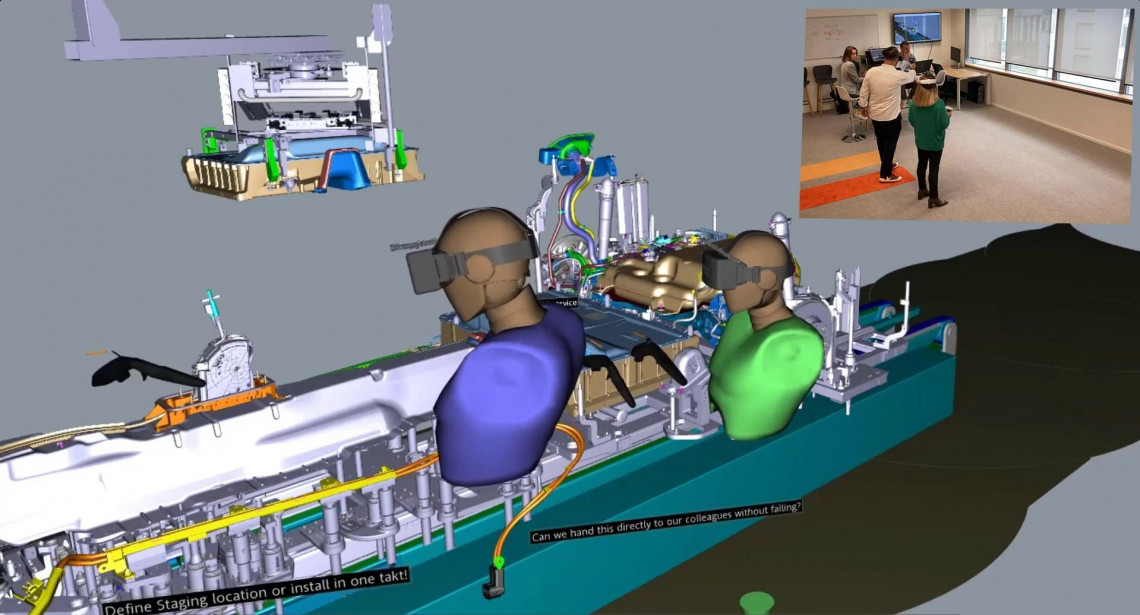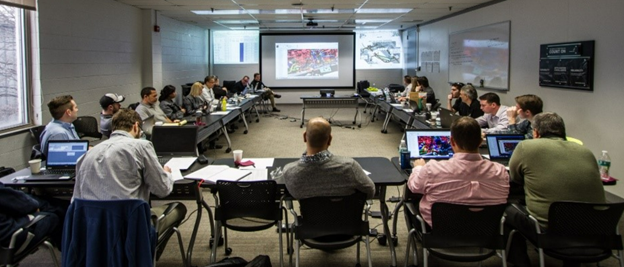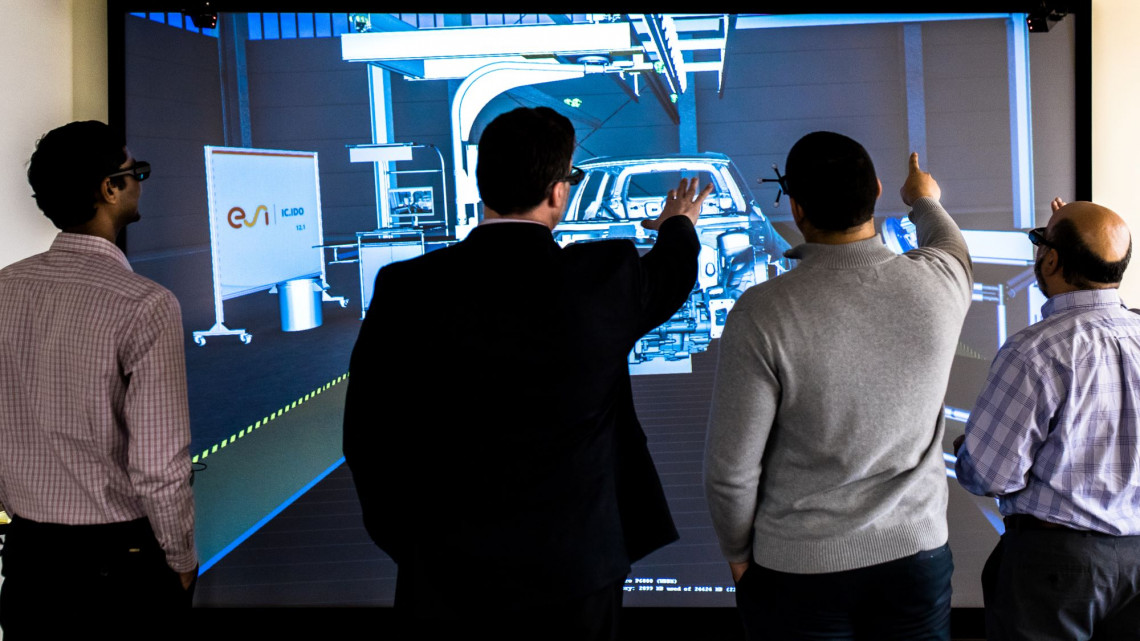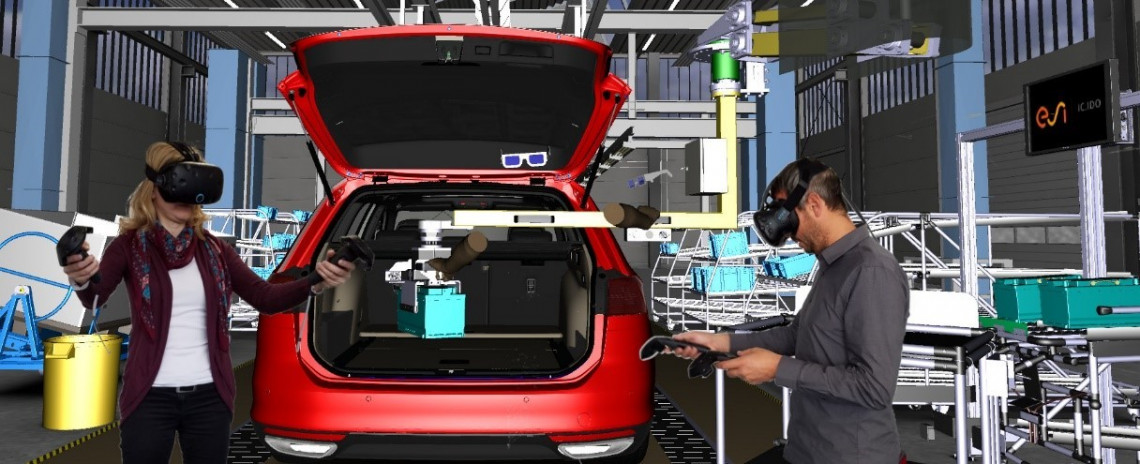The Future (Industrial Metaverse) is Already Here, it’s just Unevenly Distributed
IC.IDO from ESI has been enabling access to virtual workspaces for more than a decade

Author William Gibson, originator of the term cyberspace, penned the sentence we paraphrase for this blog post: “The future is already here, it’s just unevenly distributed”. With this as inspiration, we address a common question posed to us; “What is ESI doing regarding the Industrial Metaverse?”
Our answer: “Waiting for the world to catch up.”
This boast is made possible by the fact that among the things promised by the others when they coin the phrase “metaverse”—apologies to author Neal Stephenson—or industrial metaverse, is virtual reality collaboration in digital worlds, something that ESI IC.IDO users have been able to do for more than a decade. Ever since Head Mounted Displays arrived in mass markets, collaboration in Virtual Workspaces has been even more attainable. However, just employing VR or XR as part of the engineering workflow doesn’t conclude the ongoing journey toward that undiscovered country, the future.
Limits of conventional methods of validation
Our subscribers have over the years, implemented VR and XR powered human-centric process reviews in a variety of ways, constantly evolving to adapt to the state-of-the-art in digital engineering technology.
As digital tools displaced physical builds, milestone reviews and project gateways that used to be held in proximity of the physical mock-ups and piloting facilities declined. Rather than gathering stakeholders in a plant to conduct a physical build or teardown of new products in development, teams gathered in conference rooms to collectively review results of computer aided engineering (CAE), digital mock-ups (DMU), and other on-screen representations of proposed designs and any simulated processes.

On-screen reviews of digital design data have the advantage of being relatively low-cost, compared to the time and effort invested to conduct a physical master build. Unfortunately, the lack of appreciable scale of the products and process context when viewed on screen diminishes the value of the review or milestone by limiting the number of observations made, and investigations that could yield “accidental discovery” of potential issues.
Without the ability to experience the products in context of performing the human-centric processes, these reviews can easily devolve into high tech puppet shows that animate what some engineer invested in showing us and often only that which is prepared for us to view. In such a forum, the needs of the human service technician or assembly operator can be easily missed or misrepresented, effectively designing potential production stoppers or team-member injury.
Virtual Reality helps bring back the in-context experience
The emergence of Virtual Reality at the turn of the century, with projection based stereo visualization of product designs and interactive virtual reality physics, brought back significant value that had leaked when physical master builds were displaced by digital reviews.
Forward thinking enterprises invested in constructing Virtual Reality Centers, Powerwall installations, or Cave Automatic Virtual Environments (CAVE) that enabled groups of people to experience immersive true-to-life virtuality. Building a CAVE or Powerwall, is a significant investment that can prevent enterprises from taking the “leap of faith” and reaping the rewards in performing virtual builds as part of the engineering review.

As computing resources gained power and digital transformation evolved, new methods of generating the stereo/binocular view needed for convincing virtual reality viewpoints emerged. Head Mounted Displays (HMD), which were prohibitively expensive at the dawn of VR, became more accessible and common, kicking off a highly productive era of innovation in software and hardware.
HMDs making the metaverse mainstream
HMDs ushered in a massive expansion in the number of virtual builds or virtual service reviews performed. However, initial introductions of VR solutions, and remaining relative expense of hardware and software, leaked value again by limiting the number of participants in an interactive review or constraining other participants to participate only on-screen, or wait their turn for some time in the headset. Collaboration in such deployments had similar limitations as their CAVE or Powerwall earlier instances, locked to a particular location with a highly constrained or limited number of active participants.

Fast-forward to the current day, and consumer availability of mass-market VR headsets has completely changed the landscape of Virtual and eXtended reality. In less than a decade, the ground-breaking steps that some enterprises took to install CAVE or Powerwall at every engineering location globally looked old fashioned by comparison to using Virtual Reality on wireless HMD.
However, to reap the full value of virtual reality review we require that CAD data be as complete as possible with the least amount of non-value-added data optimization or reduction effort, provide full process interactivity and experience, and close the loop in the digital thread by connecting any findings or notes back to the source data in PLM/PDM.
Building collaboration with IC.IDO
In that regard, optimization of CAD geometry to make it light enough to fit onto lighter weight computing platforms, like the Android OS that powers many wireless HMDs, falls short of completing the journey. Fortunately, ESI and our industrial partners at NVIDIA and mutual customers like Volvo recognized the need and endeavored to build Collaborative Virtual Workspaces that accelerated Virtual Builds and Maintenance reviews without undercutting any gains earned from implementing and Virtual Build methodology.
With IC.IDO CoLab, enterprise subscribers of IC.IDO Weave can deploy Collaborative Virtual Workspaces that enable collaboration between co-located or remote team members, and experience themselves the processes that people will need to perform on the new products, and maintain a consistent digital thread.
The same engineering files that might be used by an individual tooling engineer to determine an acceptable assembly cell or maintenance environment can be seamlessly used to host a multi-user review with multiple stakeholders in immersion. Feedback in the form of digital annotations appended to specific geometry and processes can be pulled into the PDM/MPM system and merged with current data without waiting for construction of physical mock-ups, pilot plants, or prototypes.
With IC.IDO Weave, an enterprise virtual build ecosystem can be maintained with subscribers gaining access to the expert tools needed by digital mock-up professionals and virtual prototype makers to build up their assembly validation or maintenance review scene. They can then launch a collaborative virtual workspace that distributes the virtual work-product made in IC.IDO Build&Maintain or IC.IDO Integrate, and invite multiple participants to experience building or maintaining the products first-hand.
IC.IDO CoLab employs NVIDIA CloudXR to stream true-to-life virtual experiences from centralized resources to networked HMDs. When deployed well, the same computing resources that VR specialists use to author virtual builds can be used to participate in reviews, scaling the networked rendering capability to stream to HMD that otherwise could not hope to open full CAD files.
Join us in the industrial metaverse- we’re waiting for you!
We look forward to the rest of the world joining us, here in the future and our already realized “industrial metaverse”.
However, that is not to say that we are done bringing innovation to our supported workflows for validating human interactions with new products in assembly or service processes. Rather it is a stepping off point for us to highlight what is commonly possible for our subscribers (residents of that brighter future) and what is emerging with our latest releases of IC.IDO.
Check out our IC.IDO webinar series to understand more about the Industrial Metaverse, and using Virtual Reality for product and process validation.
Eric Kam is the Marketing and Alliances Director for ESI Group’s Manufacturing Business Channel, supporting their Immersive Experience (VR/AR/MR/xR) Solutions and Virtual Manufacturing Suite. He is an outspoken advocate for the ongoing transformation in Computer Aided Design, Finite Element Analysis, and Computer Aided Engineering. He has spent the bulk of the last 25 years promoting the democratization of previously “analyst-driven” technologies to bring the benefits of Virtual Engineering tools to the engineering and manufacturing practitioners themselves.